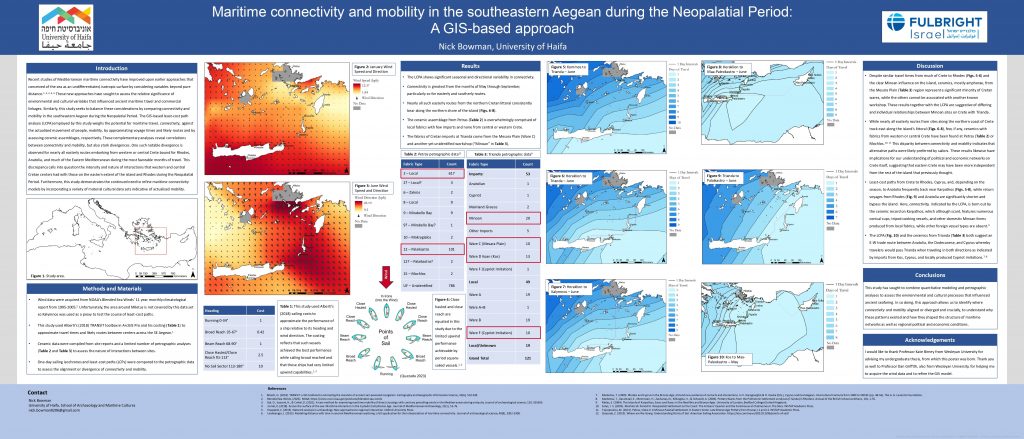February 5, 2024
At the 2024 AIA Annual Meeting (Chicago, IL), we saw a variety of posters featuring work from around the world. Annual Meeting participants were treated to an incredible array of diverse research presented in a visual format.
Three Poster Awards are given out during the Poster Award Sessions: the Best Poster Award, First Runner-Up, and the Student Poster Award.
We asked the winner of this year’s Student Poster Award a few questions about himself and his project:
Student Poster Award Recipient: Nick Bowman
“Maritime Connectivity and Mobility in the Southeastern Aegean During the Neopalatial Period: A GIS-Based Approach”

Recent studies of Mediterranean maritime connectivity have improved upon earlier approaches that conceived of the sea as an undifferentiated, isotropic surface by considering variables beyond pure distance. These approaches have sought to assess the influence of environmental and cultural variables acting on the lives of ancient mariners and the structure of maritime networks. Similarly, this study seeks to balance these considerations by comparing connectivity and mobility between Crete and Rhodes during the Neopalatial period. The least-cost path analysis (LCPA) employed by this study and created using geographic information systems (GIS) weighs the potential for ancient maritime travel, connectivity, against the actualized movement of people, mobility, by approximating travel times and likely routes and by assessing ceramic assemblages, respectively. These complementary analyses reveal correlations between connectivity and mobility, but also stark divergences, indicative of when factors beyond environmental affordances played a decisive role in shaping the maritime movement of people, goods, and ideas. One such notable divergence is observed for nearly all easterly routes embarking from western or central Crete bound for Rhodes, Anatolia, and much of the eastern Mediterranean during the most favorable months of travel. This discrepancy calls into question the intensity and nature of interactions that western and central Cretan centers had with those on the eastern extent of the island and Rhodes during the Neopalatial period. Furthermore, this study demonstrates the continued need to refine maritime connectivity models by incorporating a variety of material cultural data sets indicative of actualized mobility.
How long have you been a member of the AIA?
NB: I was a member in 2022 and then renewed my membership this fall.
How many Annual Meetings have you attended (in-person or virtually).
NB: I have attended two meetings, my first virtually and this year in person.
How did you first come to this project/topic?
NB: I first came to the project idea over the summer before my senior year of college when I was preparing my thesis proposal. I saw that while there had been past attempts to understand maritime trade and interaction through material culture and quantitative modeling, I noticed that few studies tried to combine these two approaches. The Minoans were a good case study for such an approach because of the robust maritime links they maintained with groups across the Aegean and Eastern Mediterranean and since the performance characteristics of the period’s loose-footed square sailed vessels have been thoroughly studied.
What is one cool fact or interesting result from this project that didn’t make it onto the final poster?
NB: Fact: In the region I was investigating there is a distinct lack of petrographic analyses from the Neopalatial period, so they did not make the poster by virtue of them not existing. This was a key limitation I ran up against while trawling ceramic records, which themselves were challenging to compare because of inconsistencies between reports. More petrographic studies in years to come would certainly make this study and others that consider maritime networks stronger and more nuanced.
What is your advice to students/new authors who are preparing posters for upcoming conferences?
NB: I think people preparing a poster should really just focus on doing the basics well – minimize the amount of text used (bullets for things other than the abstract), a logical visual flow, a well-conceived color scheme, and well-constructed, visually engaging, original figures/maps/tables I think are a bonus. Highlight visually, with boxes or font styles, what the viewer must know because hopefully those highlights will allow them to process the poster quickly and more importantly engage you in conversation in a less moderated format than a paper session. Save the complex analysis/interpretation for the conversation you will have for your viewers, all the need to know from the poster are the basics (the why, methods, etc.) and the implications. Do not leave gaping holes in your research obviously but give them just enough to understand and take a genuine interest in only a few minutes that will hopefully spark them to engage with you and your work